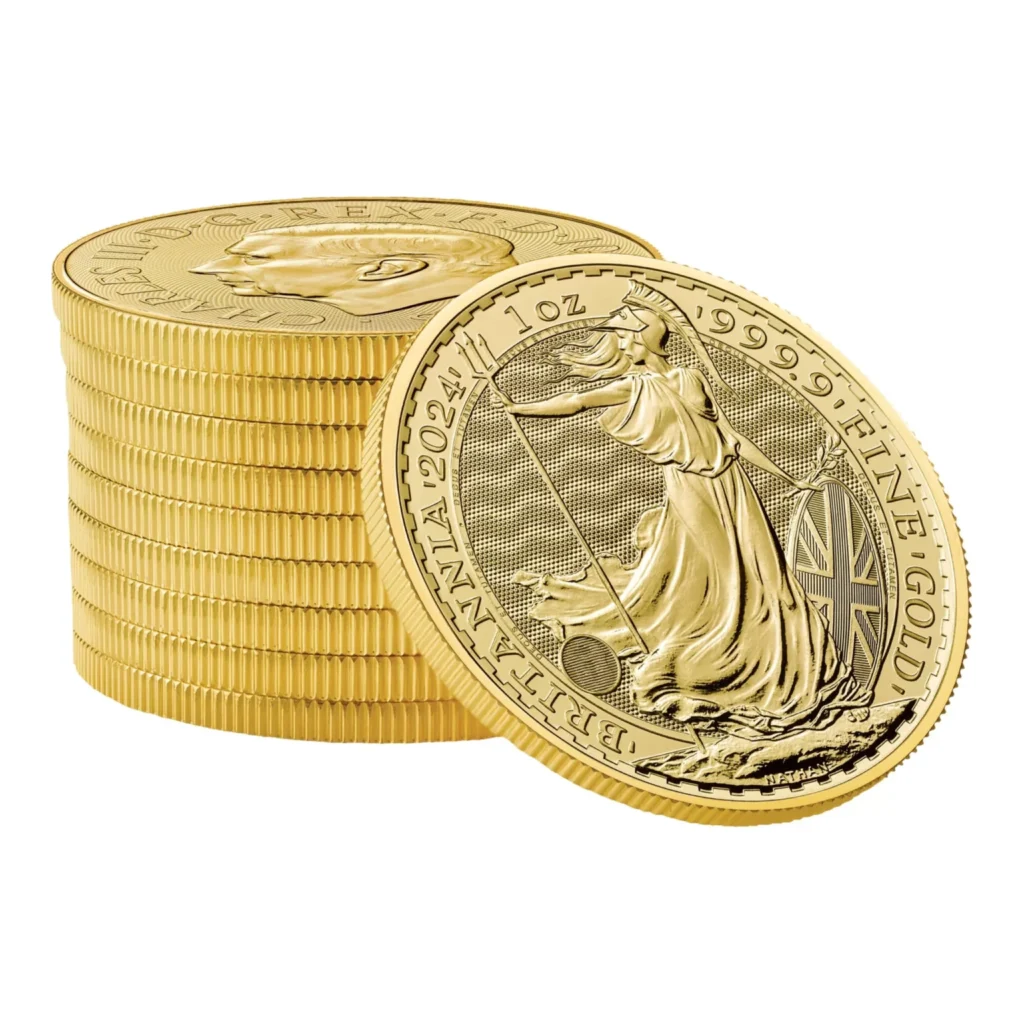When it comes to trading or investing in gold, it’s crucial to have accurate measurements and calculations. One common conversion that often arises is converting 1 oz gold into grams. Understanding this conversion is essential to ensure precise measurements and avoid any mistakes. In this article, we’ll explain the process of converting ounces to grams and provide you with the necessary information to carry out this conversion accurately.
Gold is measured in troy ounces, which differ in weight from regular ounces. One troy ounce is equal to 31.1034768 grams. Therefore, when converting 1 oz of gold into grams, you’ll find that 1 oz is equivalent to 31.103 grams precisely.
By understanding this conversion, you can ensure accurate measurements and calculations when trading or investing in gold. Whether you’re buying or selling gold, knowing the precise weight in grams is vital for determining its value. So, let’s delve deeper into the difference between ounces and troy ounces and learn more about the history and importance of using troy ounces in gold trading to navigate the industry with confidence.
Understanding The Difference Between Oz And Ozt
The avoirdupois ounce (oz) is the standard ounce commonly used in the US for measuring food and other items. In contrast, the troy ounce (ozt) is the standard measurement for precious metals. The troy ounce is slightly heavier than the avoirdupois ounce, with 1 troy ounce equal to 31.103 grams. When gold traders refer to ounces, they are usually referring to troy ounces, which is crucial to understand in the industry.
The Origin And History Of Troy Ounces
In the fascinating world of gold trading, the troy ounce plays a vital role as the standard unit of measurement for precious metals. But have you ever wondered how the troy ounce came to be? Let’s explore its origin and history.
While the exact origin of the troy ounce is not definitive, it is believed to have emerged from the bustling trade market town of Troyes in France. Troyes was a prominent center for international trade, where merchants from various corners of the world converged. As trade flourished, the need for a standardized unit of measurement for precious metals became apparent.

The story of the troy ounce is also intertwined with the ancient Roman measurement system. In ancient Rome, a unit of weight known as the troy pound was utilized. Bronze bars, widely used for trading, weighed exactly 1 troy pound. This connection between the troy pound and the troy ounce later contributed to the establishment of the troy ounce as a standardized weight for precious metals.
With the growth of trade and commerce, the troy ounce system gradually spread throughout Europe. In the early 1400s, England officially recognized the troy ounce as the official weight for precious metals. This standardization helped facilitate international trade and ensure accurate measurements in the gold and silver industry.
Across the Atlantic, the United States adopted the troy ounce as the official weight for gold and silver in the 19th century. This adoption ensured consistency in measuring precious metals and enabled seamless international transactions.
The rich history of the troy ounce showcases its significance in the world of gold trading. Understanding its origins and development helps us appreciate the precision and reliability it brings to the measurement of precious metals. The troy ounce remains a fundamental unit in the global gold market, serving as the foundation for accurate weight calculations and fair trading practices.
Importance Of Using Troy Ounces In Gold Trading
The gold industry relies on troy ounces as the standard measurement for gold, silver, platinum, and other precious metals. Understanding the use of troy ounces is crucial when discussing gold prices and sizes. It allows for accurate comparison between products measured in grams and those measured in troy ounces. This distinction is particularly important for investors who want to calculate the exact weight of their gold for trading and determine the best prices for different products.
When it comes to gold trading, knowing the weight in troy ounces is essential. The gold price is commonly quoted per troy ounce, so understanding this standard measurement is crucial for making informed investment decisions. Whether you are buying gold bars or coins, knowing the weight in troy ounces helps you evaluate the true value of your investment and compare prices accurately.
Conversions And Measurements Of Gold
Gold is measured in both grams and ounces, but the standard unit of measurement is the troy ounce. One troy ounce is equivalent to 31.103 grams. Understanding these conversions is crucial when dealing with gold, especially when comparing the prices of gold bullion coins.
When it comes to gold bullion coins, different coins may have different weights. For example, the 1 oz American Gold Eagle coin weighs 33.95 grams. It’s important to consider the purity of the gold, as coins may contain other metals that can affect the gold’s weight and value.
To visualize the value and weight of gold, let’s convert the weight of a gold coin into grams. Consider the 1 oz Canadian Gold Maple Leaf coin. Given that 1 troy ounce is equal to 31.103 grams, the weight of the Canadian Gold Maple Leaf coin is approximately 31.103 grams. This conversion allows for easy comparison and evaluation when buying or selling gold coins.
Other Gold Weights And Measurements
In addition to ounces and grams, gold can be measured in other units such as tola, tael, baht, and mesghal. These units are used in various regions and have their own conversion rates to grams or ounces. For example, 1 tael is equivalent to 37.429 grams, and 1 mesghal is equal to 4.6083 grams. It’s important to be aware of these different units and their conversions when dealing with gold on an international level.
Gold Weight Units:
- Tola: 1 tola = 11.6638 grams
- Tael: 1 tael = 37.429 grams
- Baht: 1 baht = 15.244 grams (used in Thailand)
- Mesghal: 1 mesghal = 4.6083 grams (used in Iran)
Gold Weight Conversion Tables
To facilitate gold trading and ensure accurate weight calculations, the London Bullion Market Association (LBMA) has established comprehensive conversion tables for gold weight. These tables provide conversions between grams and ounces troy, as well as other units of measurement such as tolas and taels.
The LBMA’s conversion tables are widely recognized and used in the gold industry. They offer precise measurements for fine gold content and standardize the weight of gold bars. Traders and investors can rely on these conversion tables to make accurate weight calculations, whether they need to convert grams to ounces or vice versa.
By referring to the LBMA’s gold weight conversion tables, traders and investors can confidently convert metric measurements to imperial units and ensure consistency in gold trading. These tables serve as a valuable resource for anyone involved in the gold market, providing the necessary conversions to make informed decisions and transactions.
In addition to grams and ounces, the LBMA’s conversion tables also include conversions for other gold weight units like tolas and taels. This allows for seamless international trading and ensures that measurements are accurately understood across different regions and markets.

Overall, the gold weight conversion tables provided by the LBMA are essential tools for traders and investors in the gold market. They enable precise weight calculations and ensure the accuracy and consistency of measurements, ultimately contributing to fair and transparent gold trading practices.
Conclusion
Converting gold measurements from ounces to grams is a crucial step in accurately assessing the weight and value of gold. By understanding the difference between regular ounces and troy ounces, traders and investors can ensure precise calculations and make informed decisions when trading or investing in gold.
The history of troy ounces sheds light on the importance of using this measurement in the gold industry. Hailing from the trade market town of Troyes in France, troy ounces have become the standard unit of measurement for gold and other precious metals. The adoption of troy ounces by the United States further solidified its significance in the industry.
Conversion tables provided by the London Bullion Market Association (LBMA) offer essential guidance for accurately converting gold weights, including grams to ounces and vice versa. These tables play a crucial role in standardizing weight calculations and ensuring fair transactions in the gold market.
Accurate gold weight calculations are paramount for determining the value of gold and making informed trading decisions. By utilizing conversion tables and understanding the history and significance of troy ounces, traders and investors can effectively navigate the gold market, confident in their precise measurements and calculations.
FAQ
How Do I Convert 1 Oz Of Gold Into Grams?
To convert 1 ounce of gold into grams, you need to multiply the ounce measurement by the conversion factor of 31.1034768. Therefore, 1 oz of gold is equal to 31.103 grams.
What Is The Difference Between Ounces And Troy Ounces?
The difference between ounces and troy ounces lies in the standard measurement systems. Regular ounces, also known as avoirdupois ounces, are commonly used in the US for measuring food and other items. On the other hand, troy ounces are the standard measurement for precious metals like gold. One troy ounce is slightly heavier than one avoirdupois ounce.
What Is The History Of Troy Ounces?
The origin of troy ounces is believed to be from the trade market town of Troyes in France. The need for a standard unit of measurement for precious metals arose in this international trade hub. The troy ounce system traces its roots back to the troy pound used in Ancient Rome, where bronze bars were weighed exactly one troy pound. The system spread throughout Europe and was officially established in England in the early 1400s. The United States also adopted the troy ounce as the official weight for gold and silver in the 19th century.
Why Is It Important To Use Troy Ounces In Gold Trading?
Troy ounces are the standard measurement used in the gold industry for gold, silver, platinum, and other precious metals. When discussing gold prices and sizes, it is crucial to use troy ounces for accurate measurements and calculations. This is especially important when comparing different gold products measured in grams or troy ounces. Investors should know the exact weight of gold they have for trading and calculating the best prices for different products.
Can Gold Be Measured In Units Other Than Ounces And Grams?
Yes, besides ounces and grams, gold can also be measured in units such as tola, tael, baht, and mesghal. These units are used in various regions and have their own conversion rates to grams or ounces. For example, 1 tael is equal to 37.429 grams, and 1 mesghal is equivalent to 4.6083 grams. It is important to be familiar with these different units and their conversions, especially when dealing with gold on an international level.
Are There Any Gold Weight Conversion Tables Available?
Yes, to facilitate gold trading, the London Bullion Market Association (LBMA) has established conversion tables for gold weight. These tables provide conversions between grams and troy ounces, as well as other units of measurement such as tolas and taels. The LBMA standardizes the weight of gold bars and provides precise measurements for fine gold content. Traders and investors should refer to these conversion tables to ensure accurate weight calculations.
How Important Is It To Accurately Measure And Calculate The Weight Of Gold?
Accurate measurements and weight calculations are essential when trading or investing in gold. Converting 1 ounce of gold into grams is a crucial step in accurately determining the value of gold. By understanding the difference between ounces and troy ounces, the history of troy ounces, and using conversion tables and measurements, traders and investors can make precise decisions. Ensuring accurate calculations is vital for determining the weight and value of gold and facilitating fair transactions.



